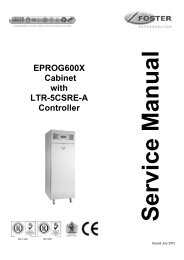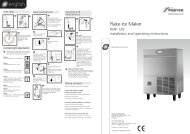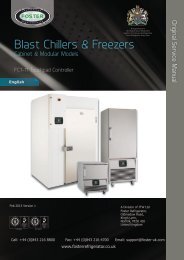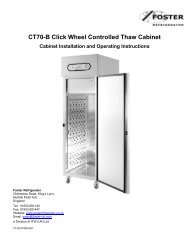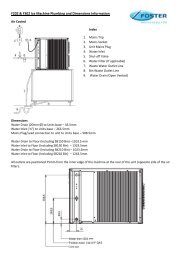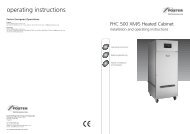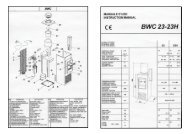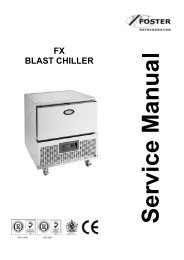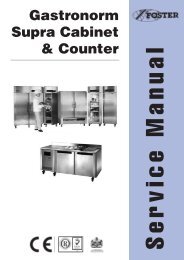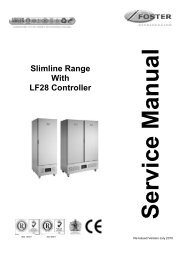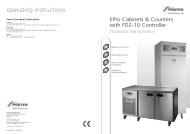Gastronorm Roll-in Cabinets S.M.indd
Gastronorm Roll-in Cabinets S.M.indd
Gastronorm Roll-in Cabinets S.M.indd
Create successful ePaper yourself
Turn your PDF publications into a flip-book with our unique Google optimized e-Paper software.
(see page 19 for general arrangement)<br />
GRL 2H<br />
7.2 The Foster CDC controller is accessible from the front of the unit for all programm<strong>in</strong>g functions.<br />
IMPORTANT - all repairs must be carried out with the ma<strong>in</strong>s electrical supply disconnected and by a competent<br />
person.<br />
7.2.1 Access to electrical connections.<br />
To ga<strong>in</strong> access to the electrical connections remove the unit cover, this is achieved by remov<strong>in</strong>g the two fix<strong>in</strong>g screws secur<strong>in</strong>g<br />
the cover to the side panels at the top and the two screws located to the bottom edge of the cover located centrally to the<br />
doors, with a sharp forward motion pull the cover from the reta<strong>in</strong><strong>in</strong>g clips. Once removed the electrical box can be seen on<br />
the left hand side. Remove the front cover to ga<strong>in</strong> access to the electrical term<strong>in</strong>als.<br />
7.2.2 Controller replacement<br />
Remove the unit cover as described <strong>in</strong> 7.2.1. Unplug the ribbon cable from the electrical box and air probe from the controller.<br />
Release the two reta<strong>in</strong><strong>in</strong>g clips fitted to each side of the controller and slide the part forward through the cutout <strong>in</strong> the unit cover.<br />
Remove it from the cover. Reverse the procedure to fit the new controller. Programme the controller us<strong>in</strong>g the <strong>in</strong>formation<br />
stated <strong>in</strong> the sett<strong>in</strong>g up <strong>in</strong>structions. (see section 4).<br />
7.2.3 Temperature probe replacement<br />
Disconnect the probe from the controller. Unscrew the clips secur<strong>in</strong>g the probe cable to the cab<strong>in</strong>et. Remove the return<br />
airduct from the cab<strong>in</strong>et by remov<strong>in</strong>g the four fix<strong>in</strong>g screws (two each side). The probe is located <strong>in</strong> a clip centrally between<br />
the fans. Release the probe from the clip and remove from the cab<strong>in</strong>et. For replacement reverse the procedure ensur<strong>in</strong>g<br />
the return airduct baffle is located correctly <strong>in</strong>to the grove at the rear of the dra<strong>in</strong> pan form<strong>in</strong>g a duct to stop short circuit<strong>in</strong>g<br />
of the airflow.<br />
7.2.4 Evaporator fan motor replacement<br />
Disconnect the fan wires from the term<strong>in</strong>al block. Unscrew the clips secur<strong>in</strong>g the fan cable to the cab<strong>in</strong>et. Remove the return<br />
airduct from the cab<strong>in</strong>et by remov<strong>in</strong>g the four fix<strong>in</strong>g screws (two each side). Slide the plastic dra<strong>in</strong> tube (located to the righthand<br />
side of the fan) from the dra<strong>in</strong> pan/evaporator fan plate. Remove the two thumbscrews secur<strong>in</strong>g the dra<strong>in</strong> pan/fan plate<br />
to the evaporator. Gently ease it away from the evaporator allow<strong>in</strong>g the cables to be withdrawn also. Remove the four screws<br />
secur<strong>in</strong>g the fan to the hous<strong>in</strong>g to disengage the fan. To replace the fan reverse the procedure ensur<strong>in</strong>g the return air duct<br />
baffle is located correctly <strong>in</strong>to the grove at the rear of the dra<strong>in</strong> pan form<strong>in</strong>g a duct to stop short circuit<strong>in</strong>g of the airflow.<br />
7.2.5 Evaporator replacement<br />
Reclaim the refrigerant gas. Remove the return airduct and dra<strong>in</strong> pan/fan hous<strong>in</strong>g as described <strong>in</strong> 7.2.4 expos<strong>in</strong>g the evaporator.<br />
Once the refrigerant gas has been reclaimed from the system cut the suction pipe close to the compressor ensur<strong>in</strong>g enough<br />
pipe is left for reconnect<strong>in</strong>g. Unbraze the capillary from the 1 /4 tub<strong>in</strong>g exit<strong>in</strong>g the drier. Seal all refrigerant pipework with tape to<br />
avoid moisture <strong>in</strong>gress <strong>in</strong>to the system. Remove the four screws (two either side) secur<strong>in</strong>g the evaporator to the plug <strong>in</strong>terior.<br />
Carefully lower the evaporator from the plug box. Once removed unbraze the pipes from the evaporator and reconnect them<br />
to the replacement <strong>in</strong> the same way. Seal all refrigerant pipes with tape after braz<strong>in</strong>g prior to refitt<strong>in</strong>g the evaporator <strong>in</strong>to the<br />
plug box. It is good refrigeration practice to replace the drier when replac<strong>in</strong>g component parts <strong>in</strong> the refrigeration system.<br />
Remove the tape from the ends of the pipes and reconnect all the pipe work. Evacuate the system and charge with the<br />
correct amount of gas as shown <strong>in</strong> the technical data. Once the system has been recharged with refrigerant check for leaks.<br />
When completed replace the dra<strong>in</strong> pan/fan plate and refit the plastic dra<strong>in</strong> tube. Refit the air return duct ensur<strong>in</strong>g the baffle<br />
is located correctly <strong>in</strong>to the grove at the rear of the dra<strong>in</strong> pan form<strong>in</strong>g a duct to stop short circuit<strong>in</strong>g of the airflow.<br />
17



